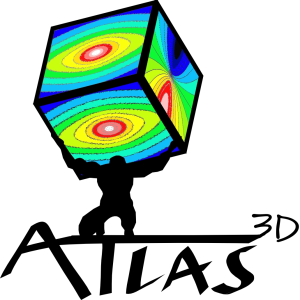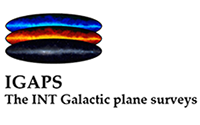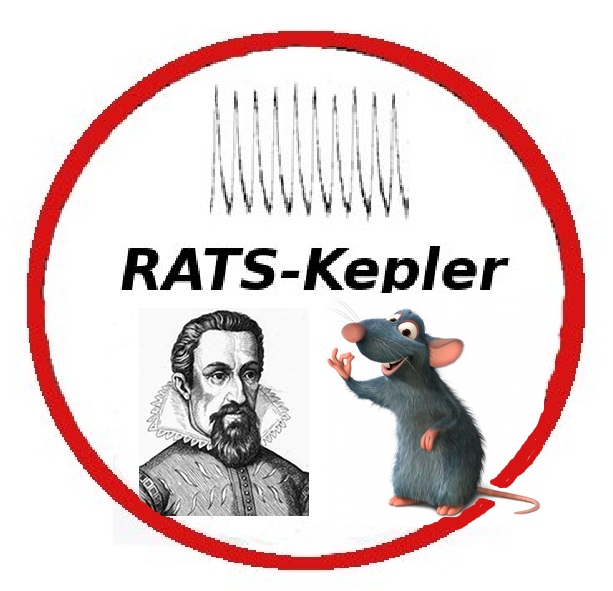 |
The ATLAS 3D Project combines a multi-wavelength survey of a complete sample of 260 early-type galaxies within the local (42Mpc) volume (1.16×10 5 Mpc 3) with numerical simulations and semi-analytic modeling of galaxy formation.The observational part of the project consists of optical integral-field spectroscopy using the SAURON integral-field unit on the William Herschel Telescope, radio observations with the Westerbork Radio Synthesis Telescope (WRST), millimeter observations with the IRAM 30m telescope and the Combined Array for Research in Millimeter-wave Astronomy (CARMA), together with deep imaging with MegaCam on the Canada-France-Hawaii Telescope (CFHT).
More. |

|
The INT Galactic Plane Survey (IGAPS) is the merger of the optical photometric surveys, IPHAS and UVEX, based on data from the Isaac Newton Telescope (INT) obtained between 2003 and 2018.
It contains 295.4 million objects providing photometry in the filters i, r, narrow-band Hα, g, and URGO. The IGAPS footprint fills the Galactic coordinate range, |b| < 5° and 30°< ℓ < 215°.
More. |
ING
Wide
Field
Imaging
Survey
|
The INT Wide Field Survey (WFS) used the Wide Field Camera (~0.3 deg 2 ) on the Isaac Newton Telescope. The WFS is an umbrella for competitively judged science programmes.
Multicolour data have been obtained over 200+ square degrees to a typical depth of ~25 mag ( U through Z). The preliminary processing and calibration (up to object catalogue generation) is the responsibility of the WFS project.
More. |
 | IPHAS is an imaging survey of the Northern Milky Way in visible light (Hα, r, i) down to >20th magnitude, using the Isaac Newton Telescope. More. |
|
KIS ‐ Kepler INT Survey
|
The Kepler INT Survey is a deep 5-filter optical survey of the Kepler field, obtained with the Isaac Newton Telescope. The survey employs ugri broad-band filters as well as Hα and is conducted by the IPHAS/UVEX collaboration, sharing the same survey pointing and data reduction strategy. Its main goals are to complement the Kepler Input Catalog by going deeper and offering additional diagnostics by adding u and Hα imaging.
More. |

|
The MILES stellar library consists of ~1000 stars spanning a large range in atmospheric parameters. The spectra were obtained at the Isaac Newton Telescope and cover the range 3525-7500Å at 2.50Å (FWHM) spectral resolution. In addition we also provide spectra for the near-IR Ca II triplet stellar library, 8350-9020Å and 1.5Å (FWHM), and SSP models. The spectral resolution, spectral type coverage, flux calibration accuracy and number of stars in both libraries represent a substantial improvement over previous libraries used in population synthesis models.
More. |

|
The Millennium Galaxy Catalogue (MGC) is a 37.5 deg 2, medium-deep, B-band imaging survey obtained with the Wide Field Camera on the Isaac Newton Telescope. The survey region is a long, 35 arcmin wide strip along the equator, covering from 10h 00m to 14h 45m and is fully contained within the regions of both the Two Degree Field Galaxy Redshift Survey (2dFGRS) and the Sloan Digital Sky Survey (SDSS).
More. |

|
The PAU Survey (PAUS) provides completed fluxed limited accurate redshift and spectral energy distribution information for millions of galaxies (and stars) to a depth and area never explored before. This is done without the need of target selection which provides a valuable tool to understand sample selection and completeness.
More. |

|
RATS-Kepler is a deep, high cadence, photometric survey of the Kepler field using the Isaac Newton Telescope and the MDM 1.2m Telescope on Kitt Peak. The goal is to identify sources located in the Kepler field of view which are variable on a timescale between a few minutes and 1 hour.
These targets would then be candidates for observation using Kepler in short cadence mode.
More. |

|
SAURON is not only a panoramic integral field spectrograph, but also a scientific project which main goal is to understand the formation and evolution of elliptical and lenticular galaxies and of spiral bulges from 3D observations. It is a survey of the kinematics and stellar populations of a representative sample of 72 nearby E, S0, and Sa galaxies observed with the integral-field spectrograph SAURON on the William Herschel Telescope.
More. |
 |
UVEX is a double-pass survey of the Northern Galactic Plane in the RGO U, Sloan g, Sloan r and the
He I 5875 filters down to g=21 using the Isaac Newton Telescope. The aim is to find hot, blue, but relatively low luminosity objects in the Galactic Plane.
Any Galactic population brighter than M V = 10 shows a strong concentration towards the Galactic Plane. Single white dwarfs and white dwarf binaries (detached, AM CVn, cataclysmic Vvriables, symbiotics), subdwarf B stars (including the ones in binaries) and extreme helium stars form the main target of the UVEX survey.
More. |

|
WEAVE (WHT Enhanced Area Velocity Explorer) is the next-generation wide-field survey facility for the William Herschel Telescope (WHT). Its wide-ranging science goals cover various fields of Galactic and extragalactic astronomy and complement the major space- and ground-based programmes, including Gaia, LOFAR and Apertif, by providing a dedicated wide-field optical spectroscopic instrument with its nearly 1000-fibre MOS mode and IFU modes.
More. |

|
WINGS (WIde-field Nearby Galaxy-cluster Survey) is an all-sky (|b|>20) survey of a complete,
X-ray selected sample of galaxy clusters in the redshift range 0.04-0.07.
The core of the WINGS project is the optical ( B, V) imaging survey. It provides
photometric data for huge samples of galaxies (~550,000) and stars (~190,000) in the inner field
(34'×34') of 77 nearby galaxy clusters, as well as structural and morphological information
for a sub-sample (~50,000) of relatively bright galaxies. Spectroscopic information for ~6,000 galaxies in 48 WINGS clusters is provided by a follow-up multi-fiber, medium-resolution survey, while additional photometric information comes from follow-up imaging surveys in the NIR and U-band (18 WINGS clusters). WINGS data were obtained mainly using the Wide-Field Camera on the Isaac Newton Telescope and AF2/WYFFOS spectrograph on the William Herschel Telescope.
More. |

